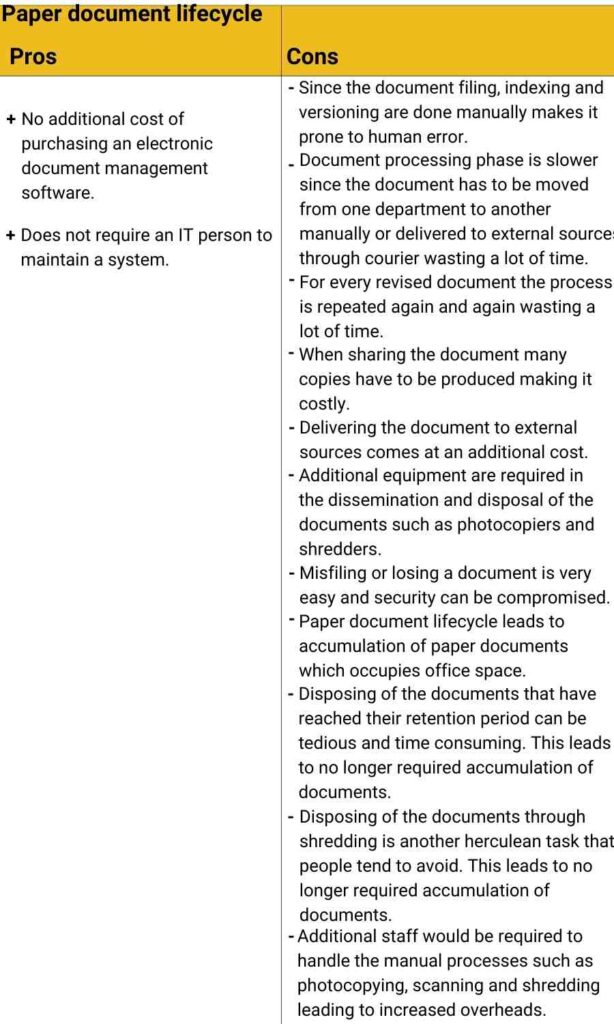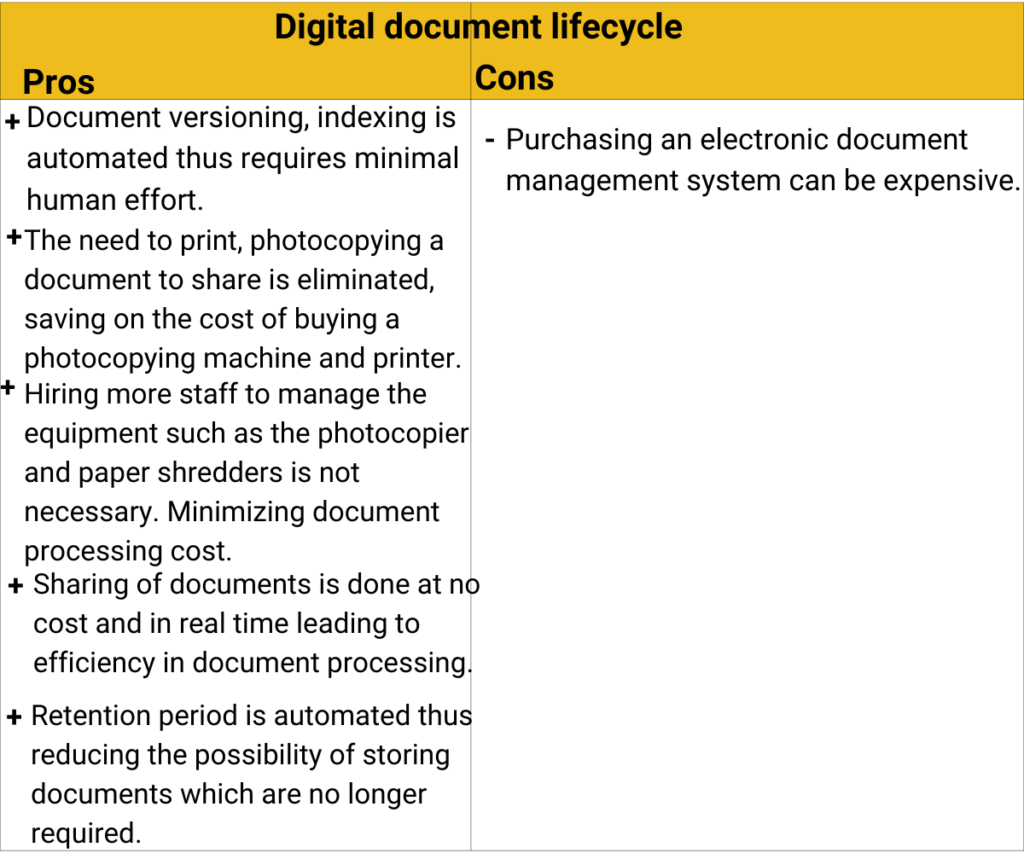What is a document life cycle?
Document life cycle helps an organization monitor and manage its work progress.A document passes through different phases as soon as the need is identified. The document will start from the creation phase to the processing phase then ending up in either the archiving phase or the disposal phase. This is determined by whether it will be required for future use or not.
A company can decide to use the paper document life cycle or the digital document life cycle or a hybrid which includes both paper and digital document.
The document creation in both the paper and digital document lifecycle start at the same point but the difference becomes a lot more conspicuous in the document processing and team collaboration.

Paper document life cycle
Document creation: In the paper document life cycle, a paper document is created by typing and printing, handwriting on paper. The paper document is also received through post or courier from the other stakeholders such as from the suppliers. The paper document can also be received through fax. The document is filed for further processing and kept in a file cabinet or locker for continuous use.
Document processing: In the paper document lifecycle the document processes are manual and are handled by different people. Different equipment is also used in processing the paper document. One person will create the paper document in the first phase but in this phase. In this phase the changes are made to the document one person at a time.
When editing, the paper document has to be moved from one desk to the other for the changes to be done. This can be very time consuming and can even take days depending on the individuals handling the document. The document versioning is also done manually and logged in manually. The indexing of the paper document is also done manually following a sequence. By the time the document is being approved it will have passed through several individuals or even departments.
After the editing and approval process the paper document is disseminated. For the paper documents duplicate copies have to be produced using photocopying equipment. This is done to enable sharing the paper document with either the internal or the external stakeholders. This depends on the type of the paper document and its purpose. In the paper based document cycle the document has to be delivered to the involved individual physically by post or courier.
Then the paper document is now put into use, where some changes might occur creating different versions of the document and this has to be documented systematically to avoid confusing the past versions with the current version.
Document disposition: In this phase the use of the paper document has reduced and it is the phase to define whether the document has to be disposed of or archived for future access.In this phase the document can no longer be edited and it is defined as the final fool proof document. The document can be retained as per the retention guidelines up to until it is due for disposal or disposed altogether. In the paper based document cycle an equipment for shredding the paper documents have to be in place to completely destroy the document reducing access to the information. If the paper document is archived, it is paper bound and stored in a well secured and tamper proof area till when its retention period is over.

Digital document life cycle
Digital document creation: is created through the use of document creation software such as Microsoft word, WPS, Microsoft excel and many others. The document could have also been received through email from external sources or a document that was delivered as a paper document externally is captured and converted into a digital document through scanning. Only one person manages the document in this phase. The digital document is stored in a central repository for further processing.
Digital document processing : In this phase a number of individuals handle the document. In the case of a digital document life cycle they can handle the document concurrently or in parallel. Changes to the document can be made at one go electronically without the need for the persons involved to move from their desks. The digital document can be worked on from anywhere and shared with the external sources at no additional cost. In this phase the digital document process is automated thus indexing and versioning is automatically created. The filing system is regulated and security of the document is ensured. Searching for the document is made easy. Also the document user can be able to access the document from anywhere on any device using their user access license using a good document management software and collaboration tools. In the digital document lifecycle systems can be integrated and synchronized increasing the security of the documents and reducing document misplacement loopholes.
Digital document disposition: The use of the document has reduced and the need to either archive or dispose of these final documents takes place at this stage. The retention policy guidelines are utilized to define whether the retention period is over. The advantage with the digital document life cycle is the retention period is automated therefore the document is purged when its due date has been reached with alerts to remind the users. This reduces the need to store documents which are no longer in use.

Conclusion
Hybrid document life cycle is usually a combination of the paper document life cycle and digital document life cycle. In some organizations some aspects of their document life cycle are in paper format and some working ins are in digital format.
This can occur when documents are created in paper format and then used in paper format but then digitized and stored in digital format. For these organizations to transform to a complete digital document life cycle is much easier than if it is a complete paper document life cycle.
To go into a completely digital document lifecycle brings efficiency into the workplace and improves on productivity level.
Which document life cycle would you be comfortable working with?

